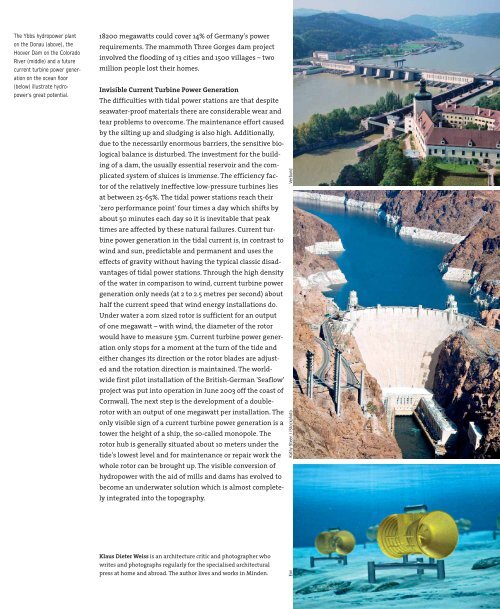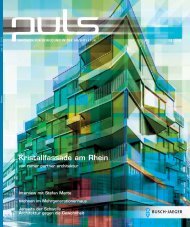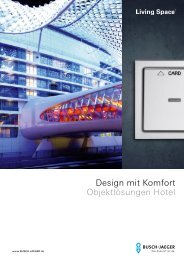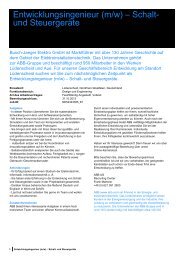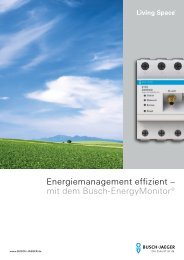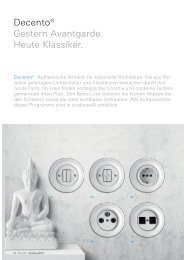The Ultimate Tower – Burj Dubai - Busch-Jaeger Elektro GmbH
The Ultimate Tower – Burj Dubai - Busch-Jaeger Elektro GmbH
The Ultimate Tower – Burj Dubai - Busch-Jaeger Elektro GmbH
Create successful ePaper yourself
Turn your PDF publications into a flip-book with our unique Google optimized e-Paper software.
<strong>The</strong> Ybbs hydropower plant<br />
on the Donau (above), the<br />
Hoover Dam on the Colorado<br />
River (middle) and a future<br />
current turbine power generation<br />
on the ocean floor<br />
(below) illustrate hydropower's<br />
great potential.<br />
18200 megawatts could cover 14% of Germany's power<br />
requirements. <strong>The</strong> mammoth Three Gorges dam project<br />
involved the flooding of 13 cities and 1500 villages <strong>–</strong> two<br />
million people lost their homes.<br />
Invisible Current Turbine Power Generation<br />
<strong>The</strong> difficulties with tidal power stations are that despite<br />
seawater-proof materials there are considerable wear and<br />
tear problems to overcome. <strong>The</strong> maintenance effort caused<br />
by the silting up and sludging is also high. Additionally,<br />
due to the necessarily enormous barriers, the sensitive biological<br />
balance is disturbed. <strong>The</strong> investment for the building<br />
of a dam, the usually essential reservoir and the complicated<br />
system of sluices is immense. <strong>The</strong> efficiency factor<br />
of the relatively ineffective low-pressure turbines lies<br />
at between 25-65%. <strong>The</strong> tidal power stations reach their<br />
'zero performance point' four times a day which shifts by<br />
about 50 minutes each day so it is inevitable that peak<br />
times are affected by these natural failures. Current turbine<br />
power generation in the tidal current is, in contrast to<br />
wind and sun, predictable and permanent and uses the<br />
effects of gravity without having the typical classic disadvantages<br />
of tidal power stations. Through the high density<br />
of the water in comparison to wind, current turbine power<br />
generation only needs (at 2 to 2.5 metres per second) about<br />
half the current speed that wind energy installations do.<br />
Under water a 20m sized rotor is sufficient for an output<br />
of one megawatt <strong>–</strong> with wind, the diameter of the rotor<br />
would have to measure 55m. Current turbine power generation<br />
only stops for a moment at the turn of the tide and<br />
either changes its direction or the rotor blades are adjusted<br />
and the rotation direction is maintained. <strong>The</strong> worldwide<br />
first pilot installation of the British-German 'Seaflow'<br />
project was put into operation in June 2003 off the coast of<br />
Cornwall. <strong>The</strong> next step is the development of a doublerotor<br />
with an output of one megawatt per installation. <strong>The</strong><br />
only visible sign of a current turbine power generation is a<br />
tower the height of a ship, the so-called monopole. <strong>The</strong><br />
rotor hub is generally situated about 10 meters under the<br />
tide's lowest level and for maintenance or repair work the<br />
whole rotor can be brought up. <strong>The</strong> visible conversion of<br />
hydropower with the aid of mills and dams has evolved to<br />
become an underwater solution which is almost completely<br />
integrated into the topography.<br />
Klaus Dieter Weiss is an architecture critic and photographer who<br />
writes and photographs regularly for the specialised architectural<br />
press at home and abroad. <strong>The</strong> author lives and works in Minden.<br />
Eon Kathy Steen / iStockphoto Verbund


